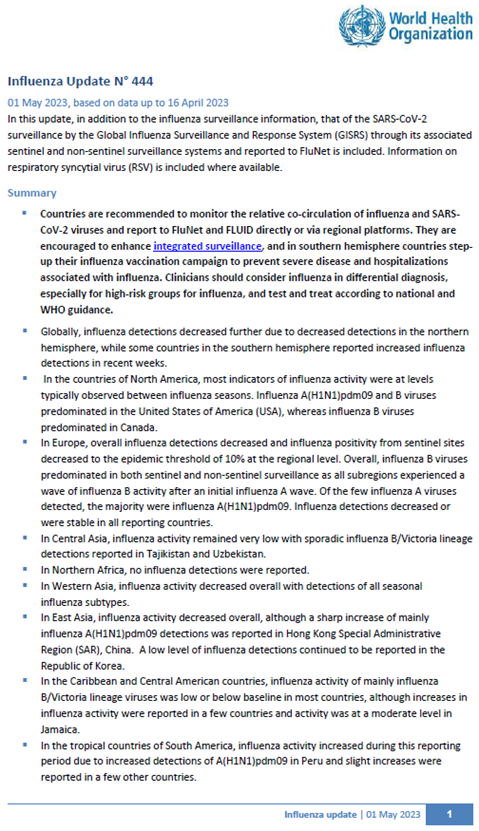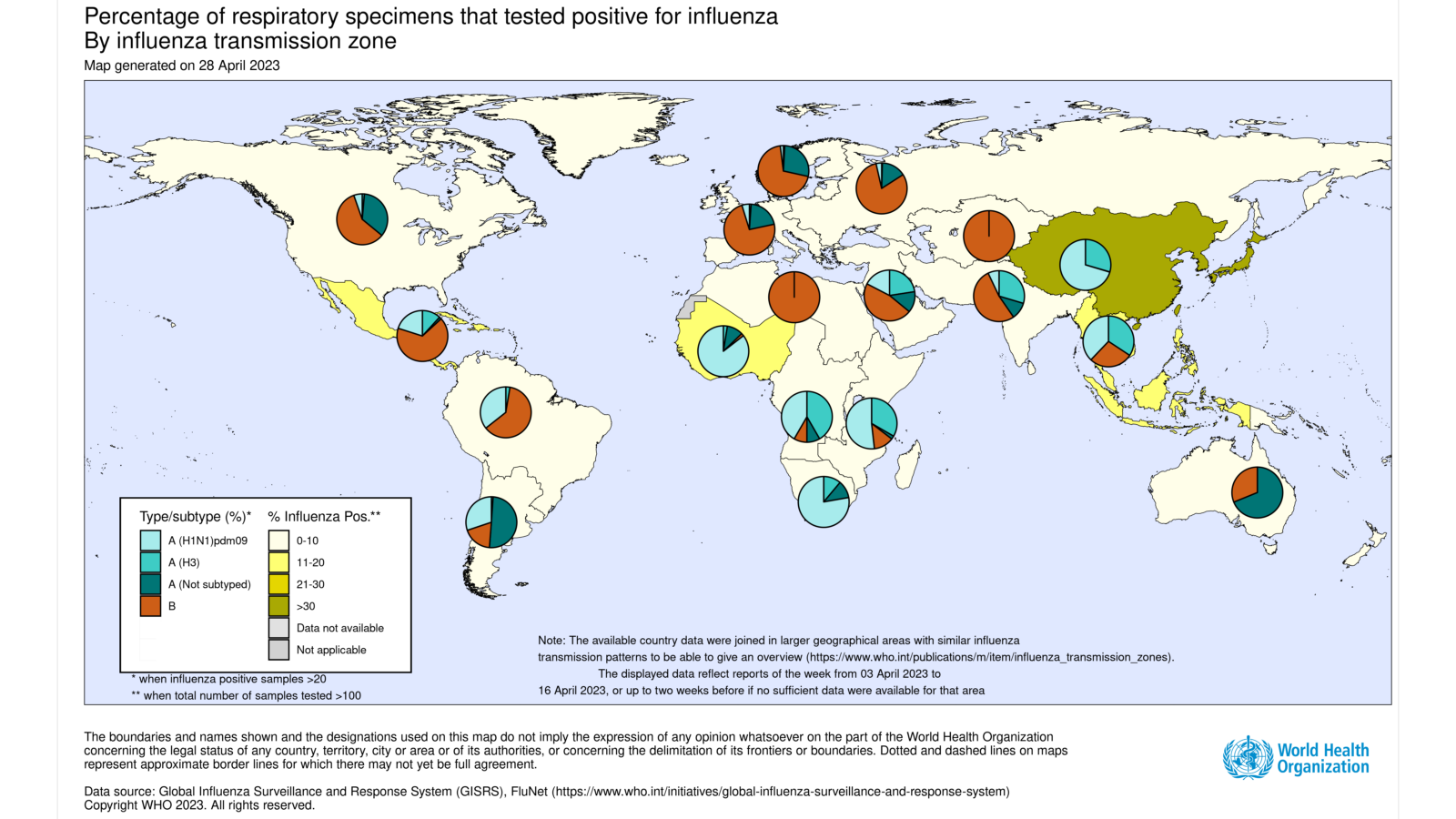Influenza Update N° 444

Overview
01 May 2023, based on data up to 16 April 2023
Information in this report is categorized by influenza transmission zones, which are geographical groups of countries, areas or territories with similar influenza transmission patterns. For more information on influenza transmission zones, see the link below:
Influenza Transmission Zones (pdf, 659kb)
- Countries are recommended to monitor the relative co-circulation of influenza and SARS-CoV-2 viruses and report to FluNet and FLUID directly or via regional platforms. They are encouraged to enhance integrated surveillance and in southern hemisphere countries step-up their influenza vaccination campaign to prevent severe disease and hospitalizations associated with influenza. Clinicians should consider influenza in differential diagnosis, especially for high-risk groups for influenza, and test and treat according to national guidance.
- Globally, influenza detections decreased further due to decreased detections in the northern hemisphere, while some countries in the southern hemisphere reported increased influenza detections in recent weeks.
- In the countries of North America, most indicators of influenza activity were at levels typically observed between influenza seasons. Influenza A(H1N1)pdm09 and B viruses predominated in the United States of America (USA), whereas influenza B viruses predominated in Canada.
- In Europe, overall influenza detections decreased and influenza positivity from sentinel sites decreased to the epidemic threshold of 10% at the regional level. Overall, influenza B viruses predominated in both sentinel and non-sentinel surveillance as all subregions experienced a wave of influenza B activity after an initial influenza A wave. Of the few influenza A viruses detected, the majority were influenza A(H1N1)pdm09. Influenza detections decreased or were stable in all reporting countries.
- In Central Asia, influenza activity remained very low with sporadic influenza B/Victoria lineage detections reported in Tajikistan and Uzbekistan. B).
- In Northern Africa, no influenza detections were reported.
- In Western Asia, influenza activity decreased overall with detections of all seasonal influenza subtypes.
- In East Asia, influenza activity decreased overall, although a sharp increase of mainly influenza A(H1N1)pdm09 detections was reported in Hong Kong Special Administrative Region (SAR), China. A low level of influenza detections continued to be reported in the Republic of Korea.
- In the Caribbean and Central American countries, influenza activity of mainly influenza B/Victoria lineage viruses was low or below baseline in most countries, although increases in influenza activity were reported in a few countries and activity was at a moderate level in Jamaica.
- In the tropical countries of South America, influenza activity increased during this reporting period due to increased detections of A(H1N1)pdm09 in Peru and slight increases were reported in a few other countries.
- In tropical Africa, influenza detections were low in reporting countries. Influenza A virus detections outnumbered B virus detections.
- In Southern Asia, influenza activity remained low with influenza A(H3N2) predominant followed by B/Victoria lineage viruses. Increased activity was reported in Bhutan and Sri Lanka.
- In South-East Asia, influenza activity remained elevated mainly due to detections in Malaysia and Singapore. In Malaysia, activity decreased but there was an increased proportion of influenza A viruses over the past several weeks and influenza A viruses predominated during this period. Influenza A(H3N2) viruses remained predominant in Singapore.
- In the temperate zones of the southern hemisphere, influenza activity remained low, however influenza activity increased slightly in Australia and Chile and in pneumonia surveillance in South Africa. Influenza A viruses were predominant and among the subtyped viruses, influenza A(H1N1)pdm09 predominated in these countries.
- Globally, RSV activity was generally low or decreasing except in Australia, South Africa and a few countries in the Region of the Americas. RSV activity decreased but remained elevated in parts of Australia. In South Africa, the RSV detection rate among children under five years of age in pneumonia surveillance seemed to have peaked a few weeks ago and has decreased to a moderate level. RSV remained elevated in Guatemala and increased in tropical South America (mainly in Bolivia (Plurinational State of)) and Colombia and some countries in temperate South America.
- National Influenza Centres (NICs) and other national influenza laboratories from 117 countries, areas or territories reported data to FluNet for the time period from 03 April 2023 to 16 April 2023* (data as of 4/28/2023 1:08:31 AM UTC). The WHO GISRS laboratories tested more than 355 524 specimens during that time period. 27 958 were positive for influenza viruses, of which 21 176 (75.74%) were typed as influenza A and 6782 (24.26%) as influenza B. Of the sub-typed influenza A viruses, 12 988 (70.16%) were influenza A(H1N1)pdm09 and 5525 (29.84%) were influenza A(H3N2). Of the characterized B viruses, 100% (839) belonged to the B/Victoria lineage.

- SARS-CoV-2 positivity from sentinel surveillance remained just above 10% globally. Activity decreased slightly to around 18% in the Region of the Americas but increased in the Eastern Mediterranean Region to just below 20%. Activity remained around or below 10% in the other regions with an increase reported in the Western Pacific Region in recent weeks. SARS-CoV-2 positivity from non-sentinel surveillance was reported around 13% globally.
- During the COVID-19 pandemic, WHO encourages countries, especially those that have received the multiplex influenza and SARS-CoV-2 reagent kits from GISRS, to conduct integrated surveillance of influenza and SARS-CoV-2 and report epidemiological and laboratory information in a timely manner to established regional and global platforms. The guidance can be found here: https://www.who.int/publications/i/item/WHO-2019-nCoV-integrated_sentinel_surveillance-2022.1.
- National Influenza Centres (NICs) and other national influenza laboratories from 77 countries, areas or territories from six WHO regions (African Region: 10; Region of the Americas: 19; Eastern Mediterranean Region: 5; European Region: 35; South-East Asia Region: 3; Western Pacific Region: 5) reported to FluNet from sentinel surveillance sites for time period from 03 April 2023 to 16 April 2023* (data as of 4/28/2023 1:08:31 AM UTC). The WHO GISRS laboratories tested more than 37 252 sentinel specimens during that time period and 5052 (13.56%) were positive for SARS-CoV-2. Additionally, more than 88 725 non-sentinel or undefined reporting source samples were tested in the same period and 18 135 were positive for SARS-CoV-2. Further details are included at the end of this update.
Source of data
______________________________________________________________________________________________
The Global Influenza Programme monitors influenza activity worldwide and publishes an update every two weeks. The updates are based on available epidemiological and virological data sources, including FluNet (reported by the WHO Global Influenza Surveillance and Response System), FluID (epidemiological data reported by national focal points) and influenza reports from WHO Regional Offices and Member States. Completeness can vary among updates due to availability and quality of data available at the time when the update is developed.
*It includes data only from countries reporting on positive and negative influenza specimens.
